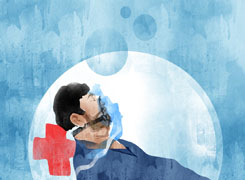Ramalingam Kalirajan |10071 Answers |Ask -Follow
Mutual Funds, Financial Planning Expert - Answered on May 20, 2024
He has an MBA in finance from the University of Madras and is a certified financial planner.
He is the director and chief financial planner at Holistic Investment, a Chennai-based firm that offers financial planning and wealth management advice.... more

I am 28 year old earning 1.2 lakhs per month. Started my first job and earning. Please suggest me how can I make 5 crore in the next 15 years. Not started any investment yet.
Understanding Your Goal
Congratulations on starting your first job and thinking about your financial future. Accumulating ?5 crore in 15 years is an ambitious yet achievable goal with disciplined investing.
Setting a Clear Plan
Since you earn ?1.2 lakhs per month, you have a significant opportunity to save and invest a substantial portion of your income. Let's break down how to approach this goal.
Emergency Fund
Before you begin investing, build an emergency fund. Save at least six months’ worth of expenses. This fund should be kept in a liquid savings account or short-term fixed deposits for easy access.
Systematic Investment Plan (SIP) in Mutual Funds
SIP is a disciplined approach to investing in mutual funds. It helps in averaging out the cost and reduces the impact of market volatility.
1. Equity Mutual Funds
Investing in equity mutual funds can offer high returns over the long term. Allocate a significant portion of your investments here.
Large-Cap Funds: These funds invest in established companies with a stable performance record.
Mid-Cap Funds: These funds have higher growth potential but come with slightly higher risk.
Small-Cap Funds: These funds offer high returns but are more volatile. Invest a smaller portion here.
2. ELSS Funds
Equity Linked Savings Scheme (ELSS) funds offer tax benefits under Section 80C and have a lock-in period of three years. They can be a good addition to your portfolio.
Public Provident Fund (PPF)
PPF is a safe and tax-efficient investment option. It offers good returns with tax benefits under Section 80C. Although it has a lock-in period of 15 years, the safety and tax benefits make it a good long-term investment.
National Pension System (NPS)
NPS is a government-backed retirement savings scheme. It offers tax benefits and a disciplined approach to retirement savings. It is a good way to ensure a steady income post-retirement.
Stocks
Direct equity investment can provide substantial returns but comes with higher risks. Start small and gradually increase your investments as you gain experience. Focus on fundamentally strong companies with long-term growth potential.
Gold
Gold can act as a hedge against inflation. Invest in gold bonds or gold ETFs instead of physical gold. Allocate a smaller portion of your investments here.
Monthly Investment Plan
Since you aim to accumulate ?5 crore, you need to invest a significant portion of your income. Considering you can save ?50,000 to ?60,000 per month, allocate your investments as follows:
Equity Mutual Funds (Large-Cap, Mid-Cap, Small-Cap): ?30,000
ELSS Funds: ?10,000
PPF: ?5,000
NPS: ?5,000
Stocks: ?5,000
Gold: ?5,000
Regular Monitoring and Review
Regularly monitor your investment portfolio. Review your investments every six months to ensure they align with your goals. Adjust allocations based on performance and changes in your financial situation.
Financial Discipline and Learning
Maintain financial discipline by sticking to your investment plan. Continuously educate yourself about personal finance and investments. Consider consulting with a Certified Financial Planner (CFP) to get personalized advice.
Conclusion
By starting early and investing wisely, you can build a substantial corpus for your financial goals. Diversify your investments across mutual funds, PPF, NPS, stocks, and gold. Maintain financial discipline and review your portfolio regularly to stay on track.
Best Regards,
K. Ramalingam, MBA, CFP,
Chief Financial Planner,
www.holisticinvestment.in
You may like to see similar questions and answers below
Ramalingam Kalirajan |10071 Answers |Ask -Follow
Mutual Funds, Financial Planning Expert - Answered on May 01, 2024
Ramalingam Kalirajan |10071 Answers |Ask -Follow
Mutual Funds, Financial Planning Expert - Answered on May 08, 2024
Ramalingam Kalirajan |10071 Answers |Ask -Follow
Mutual Funds, Financial Planning Expert - Answered on Jul 06, 2024
Ramalingam Kalirajan |10071 Answers |Ask -Follow
Mutual Funds, Financial Planning Expert - Answered on Aug 23, 2024
Ramalingam Kalirajan |10071 Answers |Ask -Follow
Mutual Funds, Financial Planning Expert - Answered on Oct 21, 2024
Nayagam P P |9796 Answers |Ask -Follow
Career Counsellor - Answered on Aug 02, 2025
Nayagam P P |9796 Answers |Ask -Follow
Career Counsellor - Answered on Aug 02, 2025
Nayagam P P |9796 Answers |Ask -Follow
Career Counsellor - Answered on Aug 02, 2025
Komal Jethmalani |410 Answers |Ask -Follow
Dietician, Diabetes Expert - Answered on Aug 02, 2025
Prof Suvasish Mukhopadhyay |2744 Answers |Ask -Follow
Career Counsellor - Answered on Aug 02, 2025
Prof Suvasish Mukhopadhyay |2744 Answers |Ask -Follow
Career Counsellor - Answered on Aug 02, 2025
Dr Nagarajan J S K |2129 Answers |Ask -Follow
NEET, Medical, Pharmacy Careers - Answered on Aug 01, 2025
Dr Nagarajan J S K |2129 Answers |Ask -Follow
NEET, Medical, Pharmacy Careers - Answered on Aug 01, 2025
Dr Nagarajan J S K |2129 Answers |Ask -Follow
NEET, Medical, Pharmacy Careers - Answered on Aug 01, 2025
Radheshyam Zanwar |6064 Answers |Ask -Follow
MHT-CET, IIT-JEE, NEET-UG Expert - Answered on Aug 01, 2025























